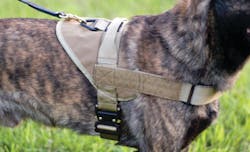At the end of last month’s article, I stated “The canine shouldn’t be biting the toy, bite pillow or sleeve until they get tired.” Not sure what I was thinking at the time or where I was going with that; probably several thought processes getting merged together into nonsense. It can be difficult to summarize months’ worth of training into a couple of pages, please bear with me.
Let’s talk for a moment about equipment. The standard choke collar should not be used. If you use a choke collar, whether you have it attached to slip (choke) or not, that puts a lot of stress on your canine, especially on their throat. Do not use a choke collar during agitation training. You should be using a 2” wide leather agitation collar, agitation harness or patrol harness. Your canine is growing into a very powerful animal and you will feel the force through the lead. With a 2” wide agitation collar, that force is spread out over the collar across their neck, so they are less likely to be injured. With an agitation or patrol harness, they are using wide leather or nylon straps, most likely 2” wide, and placing the force across the chest just below the neck. With the use of a harness, there is even less likelihood of an injury.
For working canines, I firmly believe in the decoy/helper using and not using protective equipment. Let me explain. When you hit the streets with your canine, the bad guys will not be wearing a bite sleeve or bite suit, at least we hope not. During training, the canine will not be biting an arm or leg without protective equipment, but you can do agitation work without equipment. That canine should be seeing flesh and various types of clothing. The decoy can wear short sleeves and a pair of shorts and be agitating the canine, making sure the canine is focusing on him and trying to get the bite, but doesn’t.
At this point, you have been working through the different pieces of biting equipment, the tug toy, bite pillow and soft sleeve. When you are working with bite sleeves, whether they are hard or soft, don’t offer up only one arm to bite. A lot of guys think one are is stronger than the other or are more comfortable balance wise to only use one arm for biting, but you must switch off between the arms. DO NOT offer just the right or left arm. It may not happen, but if you are doing this, in the real world of fighting crime, the canine may only target that specific arm. You will also want to incorporate leg sleeves into the training.
Just a reminder, make it fun. Although you may be using a tug toy as a reward, that sleeve (hard or soft) is also a toy to them. Don’t always give the bite command, get the bite and then out them. Have the decoy/helper slip the sleeve after the bite. By slipping the sleeve, you are providing the canine a much bigger toy/reward to play with and thrash around. Makes them feel like they have won.
Hard sleeves are great for developing the strong bite. Being that it is of hard material, the canine must bite harder in order to hold onto it. Just as you would with a soft sleeve, the decoy should be pulling the canine around, lifting them up off the ground, etc. If the canine loses the sleeve, they will want it back and over time, they will build the muscles in their jaw, making for a very strong bite.
As you progress through the training, don’t forget to use hidden sleeves. I mentioned above about the decoy wearing various clothing. Using a hidden sleeve under jackets and other various clothing will allow the canine to work on the bite, without seeing the sleeve. You do not want your canine to only bite when they can see a bite sleeve.
Throughout the training, you must work on getting the full mouth bite. The full mouth bite is the strongest bite and provides more surface are that is being held onto by the canine. If the canine is biting only with the front of the mouth, then it isn’t as strong and although the subject will have some lacerations, makes it easier for them to get out of the bite and escape.
Moving on to the bite suit; it provides the decoy protection to the entire body with exception to the head unless wearing a helmet. Up until now, the decoy has been presenting a target/threat to the canine for them to bite. Now, with the use of a bite suit, the decoy can present the arms or legs as a target/threat without switching out equipment. There are even hidden bite suits available to be worn under street clothes.
During all the training, whether it is with a sleeve or bite suit, you must conduct bite and no bite scenarios. The canine must be alert and ready to protect the handler, but not trying to bite everyone. The drive of the canine must ALWAYS be under control. If you send the canine out for an apprehension, and the subject suddenly complies upon seeing the canine coming and gets in the prone position, you should be able to call the canine off to either a heel or sit and watch, but no bite. Upon getting the bite, the canine should do as trained and stay on the subject until called off. Then the canine should release and return to the handler and not continue trying to bite the subject until told to if needed.
Canine bite work is not just for subject apprehension, but for handler protection as well. During the training, the bond between the canine and handler will become very strong. With that bond will be the natural want to protect their handler, but that should also be worked on during training. During training, you should setup various scenarios where the handler is being attacked and the canine reacts without command to protect the handler. This could be after a bite, the canine has been put in a down stay while the handler is handcuffing the subject, and the subject starts fighting/attacking the handler. Another scenario could be the canine is in the cruiser and the handler is attacked. Canine gets deployed with a remote door popper and comes to the aid of the handler.
Closing thoughts…again I want to say, make it fun for the canine. The canine wants to please you, make you happy and as the bond between you the handler and the canine, the deeper that want to please you becomes. If the canine is struggling with something, don’t get frustrated, it happens. Go back to something that the canine does well, have them do it and then reward them. The canine can get frustrated too. Remember, they want to please you and get rewarded for it. If they aren’t getting rewarded, they will get frustrated. At that point, it is pointless to continue the training; that is why you step back to something they do well, reward them and move on.
As I stated in the beginning, it is difficult to summarize months’ worth of training into a couple of pages. There is a lot involved in training a working canine. This article certainly isn’t going to cover everything, but I hope it gives you something to think about. Please feel free to make comments; we are all here to learn.
Stay Safe!
About the Author
Steven Forgues
Steve Forgues started his career over 18 years ago in Arizona. Over the years, Forgues has worked contract security, police, corrections and tactical operations. Forgues has been an instructor in various disciplines since 1998, and has been working and training with canines since 2000. Forgues has also been writing for law enforcement since 2005. He is currently working as a police officer and firefighter in Pennsylvania.

